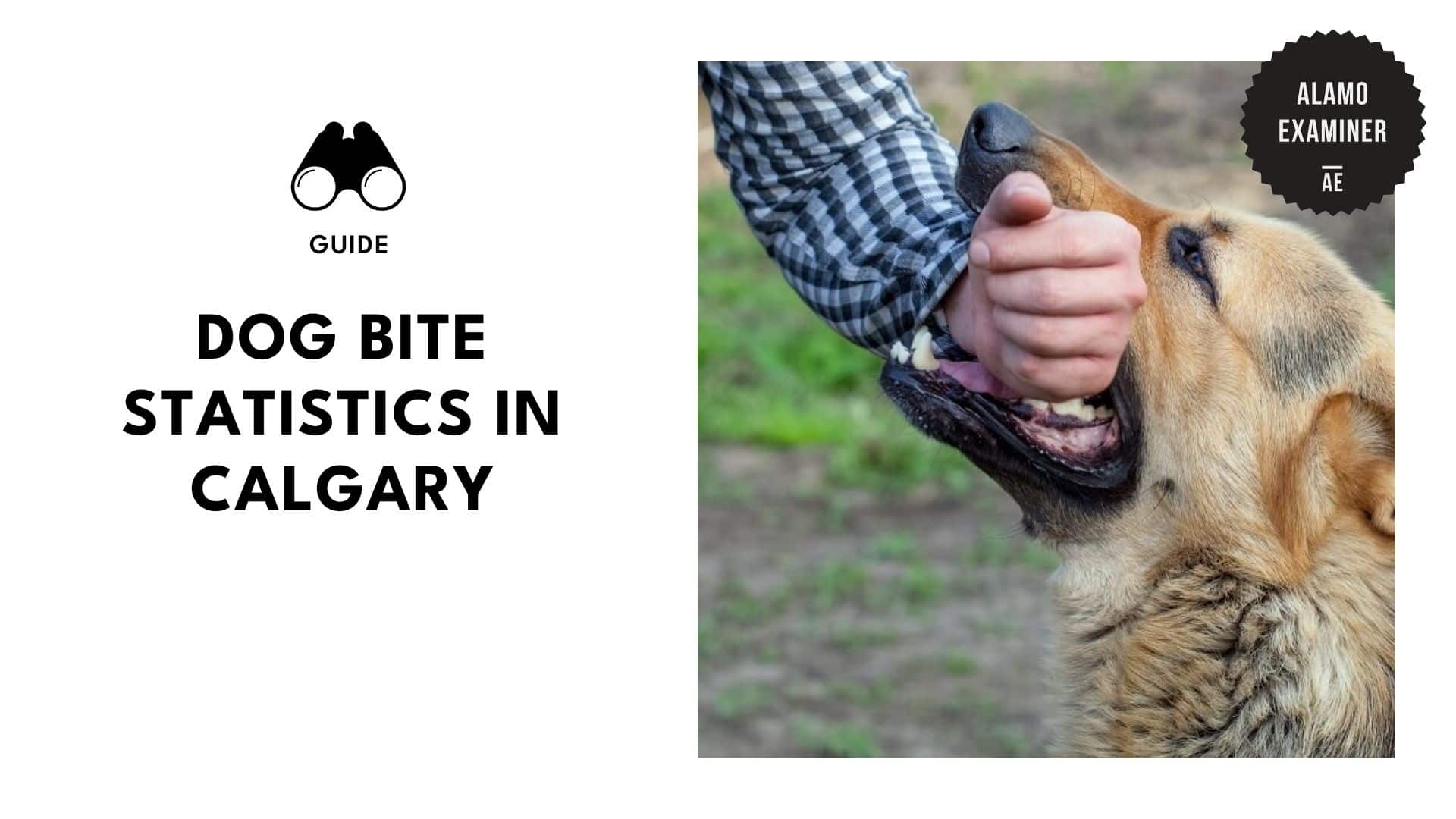Understanding Risk Through Calgary’s Dog Bite Statistics and Trends
Key Insights
| According to the University of Calgary, there were a total of 2,723 confirmed dog-related incidents in Calgary from 2012 to 2017. Data from the National Library of Medicine shows that 70% of all instances of aggression from 2012 to 2017 occurred in public spaces. The same report reveals that, according to the Dunbar scale, there were 1,023 cases recorded under level 1. These are incidents that do not cause any physical injury. From 1990 to 2007, the Prairie provinces had a total of 13 cases of dog aggression that led to death, as shown by the Fatal Dog Attacks in Canada report. Another study by the National Library of Medicine illustrates that out of all the cases in Calgary from 2012 to 2017, adults aged 20 to 59 were bitten the most, with 1,6662 incidents. |
The University of Calgary reports that between 2012 and 2017, the City of Calgary recorded 2,723 confirmed dog-related incidents involving either bites or chases.
Notably, 14% of these incidents were classified as severe, which means that nearly 1 in 6 cases involved serious injury, such as puncture wounds, deep lacerations, or multiple bite sites.
These cases often result in medical treatment and lasting trauma. In consequence, 54 dogs, or 3% of those recorded, were put down.
The accuracy of these statistics is constrained, however, by the reality that reporting is citizen-based. Numerous bite victims fail to report, especially when injuries are minor.
As a result, this implies that the number of dog-related incidents is much greater than the statistics indicate.
The report also reveals that children are the most vulnerable group to be bitten by dogs, both in Calgary and across the country.
They are more prone to being bitten than adults, and their wounds are more likely to be located on the face, head, and neck.
Two-thirds of toddlers and infants aged up to 4 years old needed emergency treatment for bites on the face or head. These injuries in the most critical regions can result in infection, scarring, and ongoing psychological trauma.
Overall, the data shows that dog-related injuries are not rare or isolated incidents but are a public safety issue, especially among young populations.
| Highlighted Metrics | Value |
| Total Dog-Related Incidents | 2,723 (including bites and chases) |
| % of incidents coded as severe | 14% |
| Dogs euthanized after investigation | 54 dogs (3% of the total) |
| Reporting reliability | Low |
| Risk of children vs adults | Higher in children |
| Cases in infants and toddlers (0 to 4 years old) | 66% are treated for facial injuries |
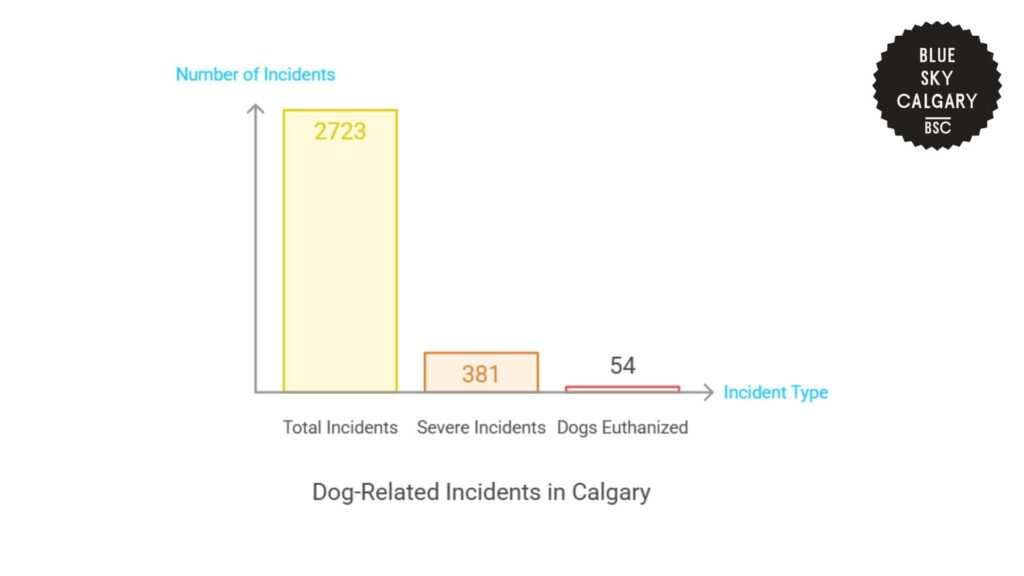
Analyzing Dog Aggression Incidents and Trends in Calgary
A report by the National Library of Medicine shows how the City of Calgary uses the Dunbar scale as a methodical tool to assess dog aggression so that every case is judged on behavior and severity of injury.
The six-level system allows animal control officers to differentiate between cases needing behavior management and those needing serious legal or safety interventions.
According to the scale, Level 1 incidents involve a snap or air bite without physical contact. These usually cause fear or anxiety but are not typically regarded as threatening.
Meanwhile, Level 2 incidents consist of tooth contact without piercing the skin. While these may bruise, they show high bite inhibition from the dog.
Both levels are classified under the city’s “Chases” dataset. These level-low cases are
early markers of behavioral problems that, if not addressed, could develop into higher-level aggression.
The “Bites” dataset records levels 3 to 5, which involve instances where the skin is penetrated.
At level 3, the dog bites and nips once and breaks the skin with one to three holes. However, these wounds are not deep and are more shallow than the length of the dog’s teeth.
Cases at Level 3.5 are slightly more severe, as these involve instances where the dog bites several times, though each bite is still at the same level as Level 3.
This level typically indicates that the dog is extremely agitated or overwhelmed and is responding without taking the time to think.
Level 4 instances indicate that the dog is no longer restraining itself. There are typically two to four deep puncture wounds due to one bite, and these punctures are deeper than the canines of the dog.
Here, the dog clamps down and tends to shake its head as well while biting, resulting in slashes or tearing on the skin. A dog that bites at this level is normally deemed dangerous.
Level 5 is a more severe case. This occurs when there are repeated Level 4 bites during a single attack.
The dog repeatedly bites with full force, making deep punctures and large injuries. This is termed a “concerted, repeated attack causing severe injury.”
Lastly, Level 6 incidents are the most severe. This is any case in which a dog’s bite causes the death of a human being or any other animal.
Using the Dunbar scale assists Calgary officers in reacting with consistency and in a just manner.
This system also helps the City of Calgary track patterns, respond based on severity, and take steps to prevent further incidents.
| Level | Bite Description | Physical Outcome | Classification |
| 1 | Air snap or no contact | No injury | Chases |
| 2 | Inhibited bite with contact, no puncture | Possible bruising | |
| 3 | One bite with 1-3 shallow punctures (more shallow than canine tooth) | Minor puncture wounds | Bites |
| 3.5 | Multiple Level 3 bites | Multiple minor punctures | |
| 4 | One bite with 2-4 deep punctures (deeper than canine tooth) with tearing or slashes | Serious injury | |
| 5 | Multiple Level 4 bites, repeated attack | Severe Injury | |
| 6 | Bite results in the death of a person or animal | Fatality |
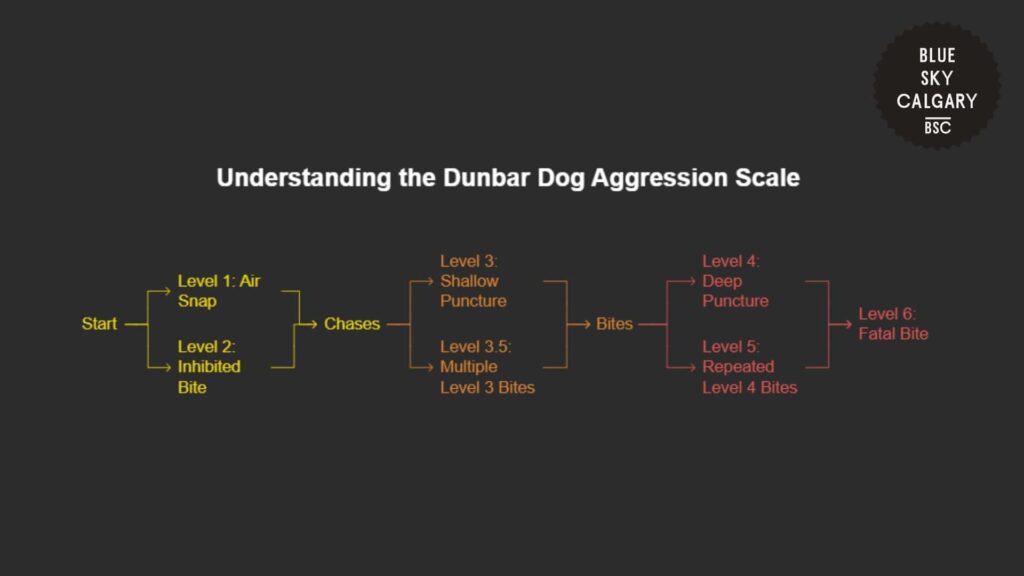
Between 2012 and 2017, the City of Calgary reported 2,713 dog aggression occurrences at Levels 1 through 5 on the Dunbar scale.
Level 1 incidents, which are air snaps or instances with no contact, comprised the biggest portion with 1,023 incidents or almost 38% of the total number of reports.
Meanwhile, Level 2 incidents, involving contact without puncture, had 368 incidents or approximately 14% of the total.
Combined, Levels 1 and 2, or “chases,” represented slightly more than half of all reported incidents (51%).
Medium-severity bites at Level 3 were also fairly common. Calgary had 955 Level 3 occurrences, accounting for 35% of the total incidents.
This suggests that skin-piercing bites, even though not as frequent as chases, happen often enough to be a public issue.
High-severity bites were less common, though these caused more damage.
Level 3.5 bites had 111 cases (4%), and Level 4 bites were at 191 cases (7%). These bites cause deeper wounds and are a result of loss in bite inhibition.
Level 5 bites, indicating repeated full-force attacks, occurred 65 times, which is just below 2.5% of all cases.
Although they are not as frequent, these high-level bites are one of the most dangerous to public safety and frequently require immediate health or behavioral intervention.
These numbers point to a trend where the majority of dogs in documented cases exercise restraint, while a minority of dogs exhibit dangerous behavior.
| Severity Level | Number of Incidents | Total (N = 2,713) |
| Level 1 | 1,023 | 37.70% |
| Level 2 | 368 | 13.60% |
| Level 3 | 955 | 35.20% |
| Level 3.5 | 111 | 4.10% |
| Level 4 | 191 | 7.00% |
| Level 5 | 65 | 2.40% |
| Total | 2,713 | 100% |

Regional Analysis of Fatal Dog Attacks in Canada
A report on Fatal Dog Attacks in Canada gives insights into the distribution of reported fatal dog attacks across the country from 1990 to 2007.
Although these instances are less frequent when compared to low-severity attacks, these cases provide vital information on fatal dog aggression in different provinces.
The data indicates that almost half of these deaths took place in the Prairie provinces of Manitoba, Saskatchewan, and Alberta, which collectively contributed to 13 fatalities or 46.4% of the country’s total of 28 cases.
This regional disparity brings concern to possible contributing factors like dog population density, enforcement policy, or emergency response availability in rural compared to urban areas.
Central Canada, comprising Ontario and Quebec, accounted for 8 deaths, which is 28.6% of the total.
These two provinces are Canada’s most populated areas, and although their death toll is fewer than that of the Prairie provinces, it is still a significant percentage of all deadly attacks across the country.
Both the Atlantic area, New Brunswick and Newfoundland, and the Northern region, Nunavut and Northwest Territories, each reported 3 fatalities, which represent 10.7% for both regions.
These numbers imply that fatal dog attacks are not limited to metropolitan areas or densely populated locations.
British Columbia had a single reported fatal dog attack during these 17 years, which is the lowest of any region at 3.6%.
| Region (Provinces or Territories) | Number of Fatalities | % of Total (N = 28) |
| Prairie (MB, SK, AB) | 13 | 46.40% |
| Central (QC, ON) | 8 | 28.60% |
| Atlantic (NL, NB) | 3 | 10.70% |
| Northern (NT, NU) | 3 | 10.70% |
| Western (BC) | 1 | 3.60% |
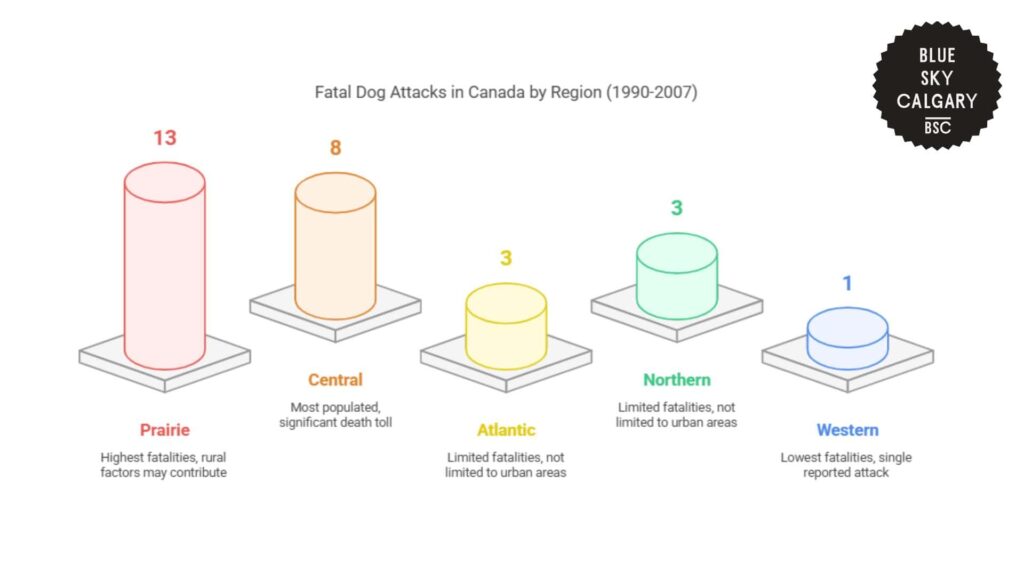
Dog Aggression Trends in Calgary
The National Library of Medicine’s report on dog aggression illustrates relevant patterns concerning incidents in Calgary.
Trends by Location
Public spaces were the most frequent location of incidents involving dogs. Amongst all the cases reported, 1,888 took place within public places, which is 70% of all instances.
575 of these cases were at medium severity (Level 3), and 1,136 were at low severity (Levels 1 and 2). 177, representing 9.4% of all public-area cases, were of high-severity bites (Levels 3.5, 4, or 5).
The sheer number of public-area cases indicates a high risk of exposure in communal community areas. This is possibly because dogs in these areas do not have existing relationships with the people here, which could increase the chance for aggression.
Meanwhile, cases in the owner’s property were at 437 instances, or 16% of total incidents. These were spread more evenly by severity level, with 176 low severity, 183 medium severity, and 78 high severity.
These results indicate a higher risk of escalation on private property, perhaps due to perceived territorial threats or the absence of supervision.
In-house incidents at 227 cases, represented 8% of the total. Even though they were fewer in number, there was a much greater chance of in-house cases being serious.
Only 22 were low severity, 110 were medium severity, and 95 were high severity. Thus, 42% of in-house accidents led to high-severity injuries, which is the highest percentage across all locations.
These results show that familiar locations do not result in lower risk and can instead be linked with more severe attacks, perhaps because victims are likely to come in close contact with the dog.
Off-leash parks recorded the lowest incidents at 161, or 6% of the total. Here, there were 57 cases of low severity, 87 of medium severity, and just 17 of high severity.
This implies that even though off-leash parks involve risk, such incidents are less likely to happen than in other locations.
Overall, the data shows that in-home locations, although registering fewer total cases, recorded the highest proportion of severe bites.
Meanwhile, public locations, though having more frequent cases, had a lower severity ratio compared to volume.
| Location | Total Cases | Low Severity (Level 1–2) | Medium Severity (Level 3) | High Severity (Levels 3.5–5) |
| Public | 1,888 | 1,136 | 575 | 177 |
| Owner’s Property | 437 | 176 | 183 | 78 |
| In House | 227 | 22 | 110 | 95 |
| Off-Leash Park | 161 | 57 | 87 | 17 |
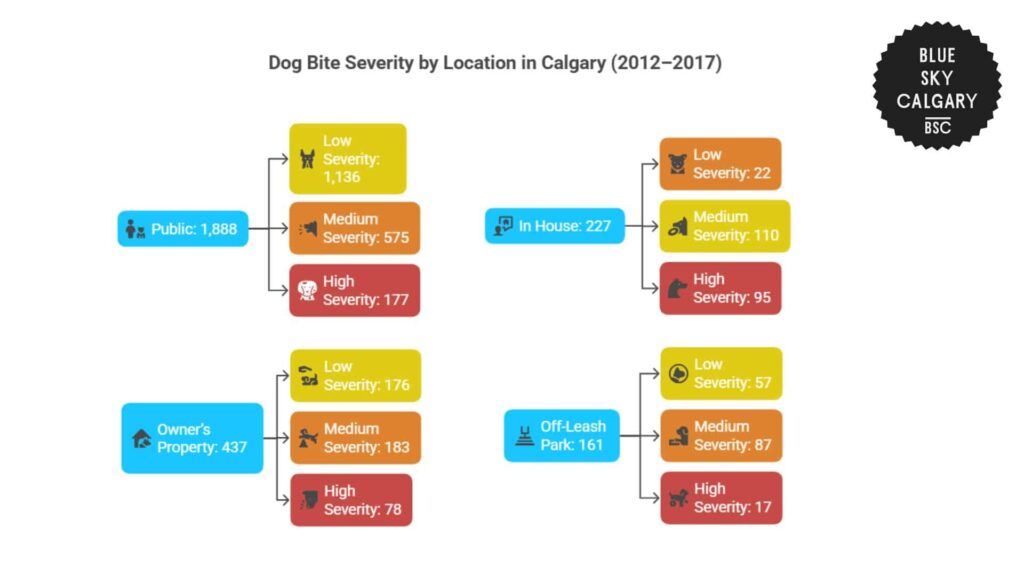
Demographic Breakdown of Victims of Dog Aggression in Calgary
The National Library of Medicine breaks down the number of incidents of dog aggression incidents based on specific demographic groups in Calgary.
Trends by Age
The data shows that out of 2,713 cases, adults between the ages of 20 and 59 were bitten the most.
Adults aged 20 to 59 made up 1,662 incidents, which is 61% of the total number of cases. Most of them were medium severity (904 incidents), followed by high severity (569 incidents) and low severity (61 incidents).
This indicates that adults are the most common victims, but most of these cases were not critical puncture wounds.
Children aged 0 to 12 were the second most often bitten group and had 455 reported incidents. Of these, 87 were high-severity bites, which make up 19.1% of child victim cases.
Aside from this, 202 cases among children were of medium severity, and just 17 were of low severity. This implies that in the event children are bitten, the result tends to be more severe.
Meanwhile, older people aged 60 and older were involved in 304 incidents. Of these, 53 were of high severity, accounting for 17.4% of incidents within their category.
Similar to children, older adults had a larger percentage of serious bites, illustrating their physical vulnerability.
Adolescents aged 13 to 19 made up the smallest number of cases, at 157. This group had 20 high-severity incidents, which is 12.7% of the cases in their category.
Overall, adults were the most frequent victims by number, but children and elderly people were at greater risk of serious injury if bitten.
| Age Group | Total Cases | Low Severity (Level 1–2) | Medium Severity (Level 3) | High Severity (Levels 3.5–5) |
| Child (0–12) | 455 | 17 | 202 | 87 |
| Youth (13–19) | 157 | 6 | 71 | 20 |
| Adult (20–59) | 1,662 | 61 | 904 | 569 |
| Older Adult (60+) | 304 | 11 | 137 | 53 |
| Unknown | 135 | 5 | 77 | 18 |

Trends by Gender
Out of a total of 2,707 cases that recorded victim gender, males suffered just slightly more incidents than females.
Severity distribution by gender was also fairly consistent, reflecting no clear gender-based discrepancy in dog aggression.
Of the total, 1,387 of the victims were male and comprised 51% of the cases. Among the male victims, 104 were low severity, 760 were medium severity, and 523 were high severity.
This shows that 37.7% of male victims suffered bites in the Level 3.5 or higher range.
Meanwhile, women had 1,320 of the cases and made up 49% of the total. This category reported 96 low-severity, 717 medium-severity, and 507 high-severity attacks.
The high severity rate for females was 38.4%, which is almost the same as the rate for male victims.
These statistics indicate that dog aggression is present in both genders at more or less the same frequency overall and in the chances of getting a severe injury.
| Gender | Total Cases | Low Severity (Level 1–2) | Medium Severity (Level 3) | High Severity (Levels 3.5–5) | % High Severity |
| Male | 1,387 | 104 | 760 | 523 | 37.70% |
| Female | 1,320 | 96 | 717 | 507 | 38.40% |
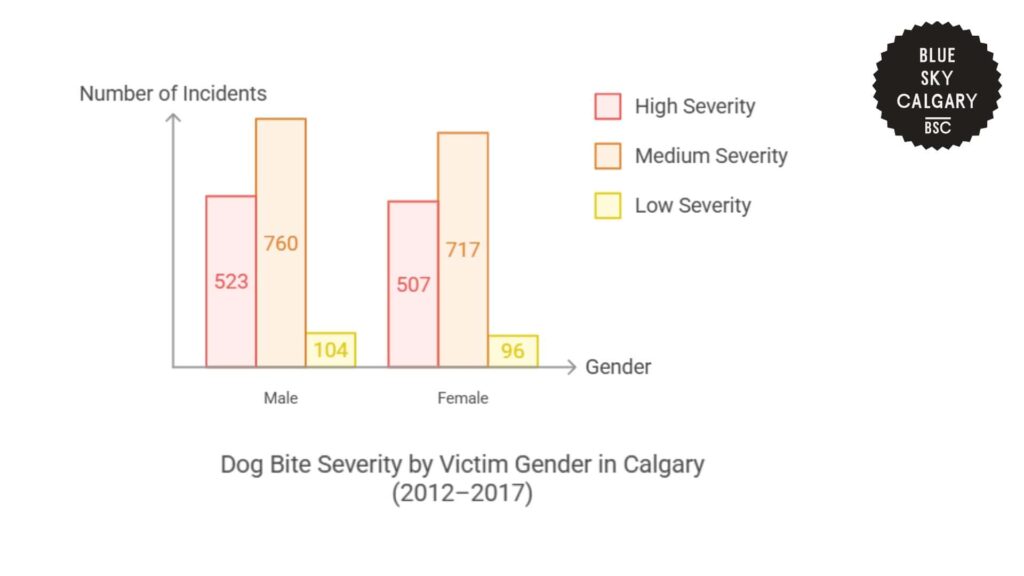
Costs and Consequences of Dog Bite Incidents in Calgary
Dog bite attacks in Calgary can have lasting and frequently severe physical, psychological, and economic impacts on victims.
Preszler illustrates how these injuries are not only painful but also carry considerable medical as well as legal consequences.
Physically, dog bites can result in injury beyond surface wounds. Victims can be disfigured, suffer facial injury, damage to nerves and tendons, broken bones, or, in the worst of cases, amputations.
If not treated immediately, infections like rabies, tetanus, or MRSA may result, complicating the recovery process further.
Medical treatment for these types of injuries typically involves emergency room stays, operations, antibiotics, wound treatments, and prolonged rehabilitation.
For more serious injuries, like those involving bites on the face or neck, expert treatment in the form of plastic or reconstructive surgery may also be needed. These require significant out-of-pocket expenses without insurance coverage.
In addition to physical damage, dog attacks have demonstrated psychological impacts. Many victims experience post-traumatic stress disorder (PTSD), generalized anxiety, depression, or a lifelong fear of dogs.
These psychological effects are most common among children, who are also more susceptible to severe incidents.
Legally, Calgary does have strict accountability measures through its Responsible Pet Ownership Bylaws.
Dog owners can be fined as much as $10,000 for bites or attacks, particularly if their dog was not under restraint or was known to be aggressive.
Beyond enforcement at the municipal level, victims also have the option to engage in civil courts for damages.
A victim may seek compensation such as medical bills, psychological therapy, lost wages, and non-monetary damages.
Owners might also be ordered to pay legal costs, behavior modification classes for the dog, and other court-ordered sanctions.
| Category | Impact |
| Physical Injuries | Disfigurement, fractures, infections, etc. |
| Psychological Harm | PTSD, anxiety, phobias |
| Medical Costs | Emergency treatment, surgeries, therapy |
| Legal Liabilities | Fines up to $10,000, penalties |
| Additional Consequences | Loss of income, quality of life reduction |
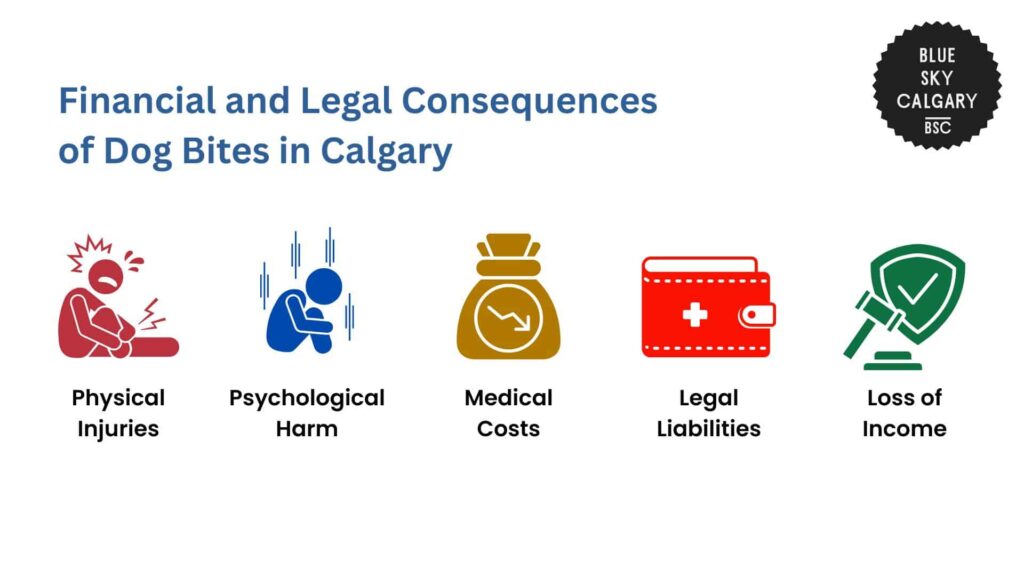
Interventions and Solutions to Dog Bite Incidents in Calgary
To meet the persistent rate of dog aggression attacks, most notably ones that target children, the City of Calgary’s Animal Care and Pet Licensing team launched the Wise Whiskers program.
This is a specific dog bite prevention program targeted towards fifth and sixth graders. Moreover, this age range was selected based on the number of incident reports affecting children and the readiness for learning of this group.
Kids in this age bracket are mature enough to understand safety guidelines and are one of the most common victims of dog bites.
The program educates children on how to read dog body language, safely interact with animals, and react correctly when faced with an unfamiliar or aggressive dog.
These skills are based on animal control research that indicates a high percentage of bites happen when a child unknowingly incites a dog, generally through a misreading of signals or intrusive play.
One of the primary goals of the curriculum is reading the body language of dogs. Students learn to recognize typical warning signals like growling, lip licking, yawning, tucking the tail, and rigidity.
Another section of instruction is on safe ways around dogs. This involves always having a dog owner’s permission before approaching, allowing the dog to sniff first before being petted, and avoiding hugging or any startling movements.
Lastly, the program trains students in de-escalation techniques for practical applications. Children are taught what to do if a dog is coming towards them, which includes standing still “like a tree,” looking away, and talking softly.
These methods aim to reduce the perceived threat to the dog and minimize the likelihood of an attack.
| Focus Area | Instructional Content |
| Recognizing Dog Behavior | Teach signs of fear or aggression of dogs like growling or tucking of tail |
| Safe Interaction | Asking permission, gentle petting, avoiding risky actions |
| De-escalation Techniques | Avoiding eye contact, standing like a tree |
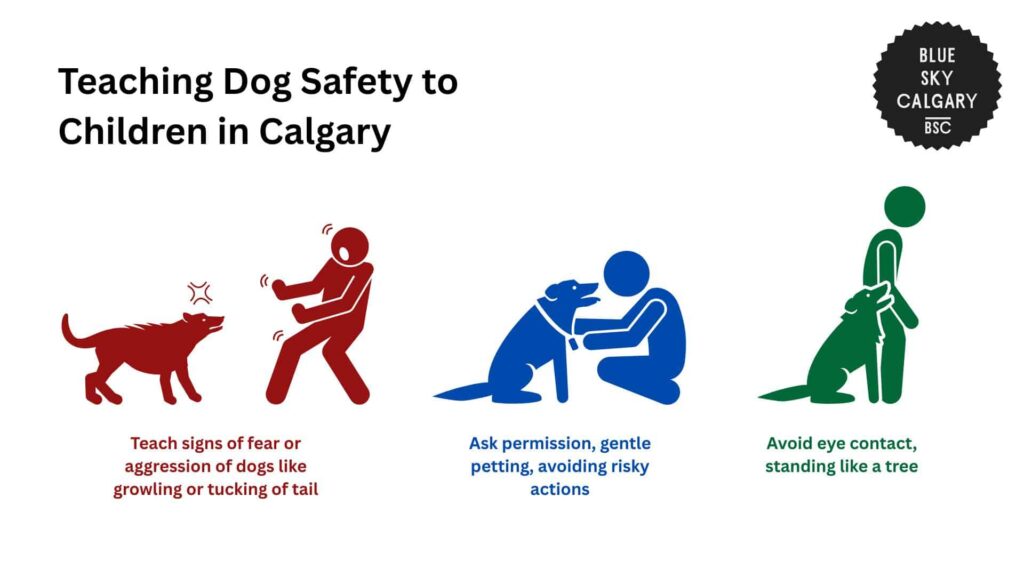
The Future of Dog Aggression Incidents in Calgary
Based on data from 2012 to 2017, Calgary recorded 2,713 dog aggression incidents, with an average of approximately 452 cases per year.
Unless new, large-scale interventions related to pet ownership are introduced, this number is unlikely to change anytime soon.
However, the victim types, locations, and severity of dog-related aggression incidents could change based on continued interventions by the city government.
With Calgary’s ongoing initiative of school-based prevention programs, child incidents may decrease over time, especially in public places where the highest number of incidents related to dogs currently occur.
Moreover, the persistent enforcement of ordinances aimed at dog behavior and education regarding responsible pet ownership may also help to significantly reduce the total number of incidents.
Achieving long-term declines in high-severity incidents will depend on whether these educational initiatives are properly pursued and maintained.
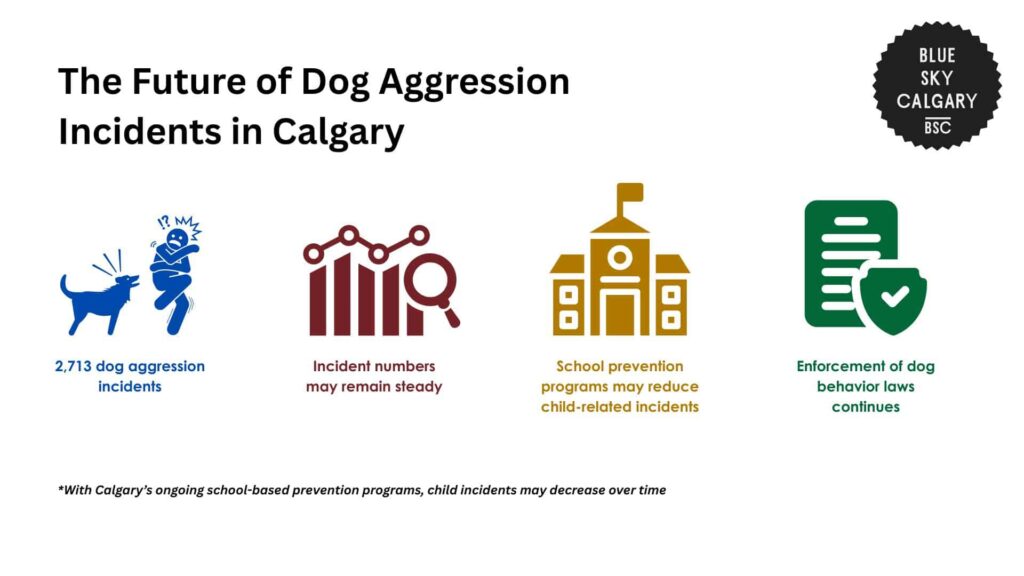
References
- Rock, M. J. (2021, October 27). Dogs, bites, and public health: Working across boundaries to prevent injuries and promote health equity [PDF]. University of Calgary Cumming School of Medicine. https://cumming.ucalgary.ca/sites/default/files/teams/251/MelanieJRock_UCalgary_CalgaryPublicLibrary_v27Oct2021_18h.pdf
- Chang, Y. P., McConnell, M., & Tetens, J. (2019). Dog bite injuries in children: A five-year review of admission trends, demographics, and patient outcomes. Cureus, 11(6), e4947. https://doi.org/10.7759/cureus.4947
- Diamond and Diamond Lawyers. (n.d.). What are the laws about dog bites in Canada? https://diamondlaw.ca/blog/what-are-the-laws-about-dog-bites-in-canada/
- Preszler Injury Lawyers. (n.d.). Dog attack lawyer – Calgary. https://www.preszlerlawalberta.com/calgary/dog-attack-lawyer/
- City of Calgary. (2023, May 1). City introduces dog bite prevention program aimed at fifth and sixth graders. https://newsroom.calgary.ca/city-introduces-dog-bite-prevention-program-aimed-at-fifth-and-sixth-graders/
- City of Calgary. (n.d.). Home. https://www.calgary.ca/home.html
- Bernardo, L. M., Gardner, M. J., Rosenfield, R. L., Cohen, B., & Pitetti, R. (2008). A comparison of dog bite injuries in younger and older children treated in a pediatric emergency department. Pediatric Emergency Care, 24(3), 137–141. https://doi.org/10.1097/PEC.0b013e3181666f82
- Chang, Y. P., McConnell, M., & Tetens, J. (2019). Dog bite injuries in children: A five-year review of admission trends, demographics, and patient outcomes. Cureus, 11(6), e4947. https://doi.org/10.7759/cureus.4947

